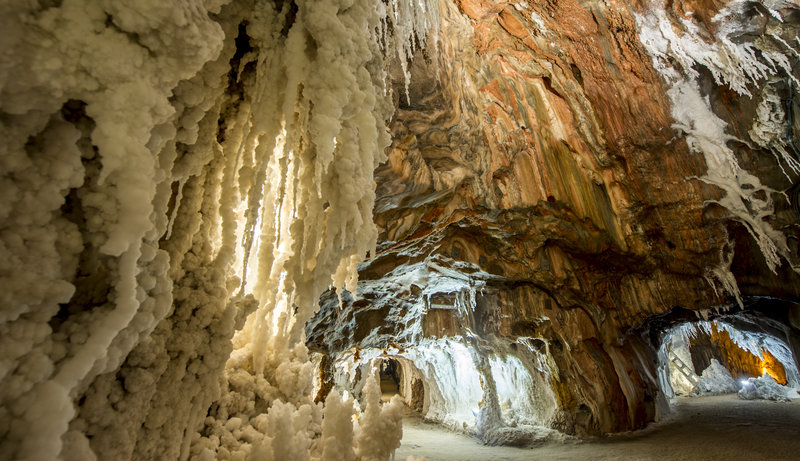The secrets of Cardona’s salt mountain
The Salt Mountain is a unique natural phenomenon on the planet that grows as rain erodes it. Its 120 metres in height are just the tip of a huge diapir (a geological structure consisting of mobile material that was forced into more brittle surrounding rocks) about two kilometres deep.
Known as the Nieves mine, for years the site was one of the most important potassium salt mines in the world. Today, the old mining site has been converted into the Salt Mountain Cultural Park, a large cultural facility that aims to communicate the importance of salt, the geological exceptionality of the site, and the use that man has made of this resource for centuries.
The guided tour takes the visitor inside the galleries of the Salt Mountain, which have been open since 1997. The visit reveals the splendour of the different folds and veins of the site and the diversity of its minerals.
A walk through the old mining facilities beneath the imposing headframe of the old mineshaft, known as Maria Theresa, brings us to the museum area, an open space that tells the story of the exploitation of the salts, geology, mineralogy and botany of this area of natural interest, the Salt Valley of Cardona. A visit to the mineshaft machine building reveals a gem of industrial archaeology: the shaft’s machinery that was designed and built by Alsthom (now Alstom) in the 1920s. In the basement there is a photography exhibition.
The old carpentry and mechanical workshop today houses the Salt Handicraft Centre and the “Memory of the Women of the Mining Colonies” exhibition. Here there is also a cafeteria and an outdoor terrace, while La Botigueta shop at the reception has a wide range of products and literature about Cardona.
Cardona Castle
If there’s time, you can also visit the imposing Cardona Castle, which was the residence of the Lords of Cardona during the Middle Ages. Centuries of history lie behind this unbreachable fortress, which is also the site of the remarkable Collegiate Church of Sant Vicenç, a jewel of Catalan Lombard Romanesque architecture. Two tours allow the visitor to relive sieges and battles and discover why the Lords of Cardona were known as the Kings without a Crown.
out & about
The Alchemy Project
An alternative tour is the “Alchemy Project: the Secret of the Liber Salis”. This theatrical visit focuses on siblings and scientists, Carlota and Tomeu Bartomeu. They are descendants of Guillem Bartomeu, a medieval alchemist and author of the Liber Salis, the book of salt, where he collected all his knowledge. Centuries later, one of the Bartomeu siblings invites us to accompany him in the final phase of the Alchemy Project: the discovery of a new mineral.

